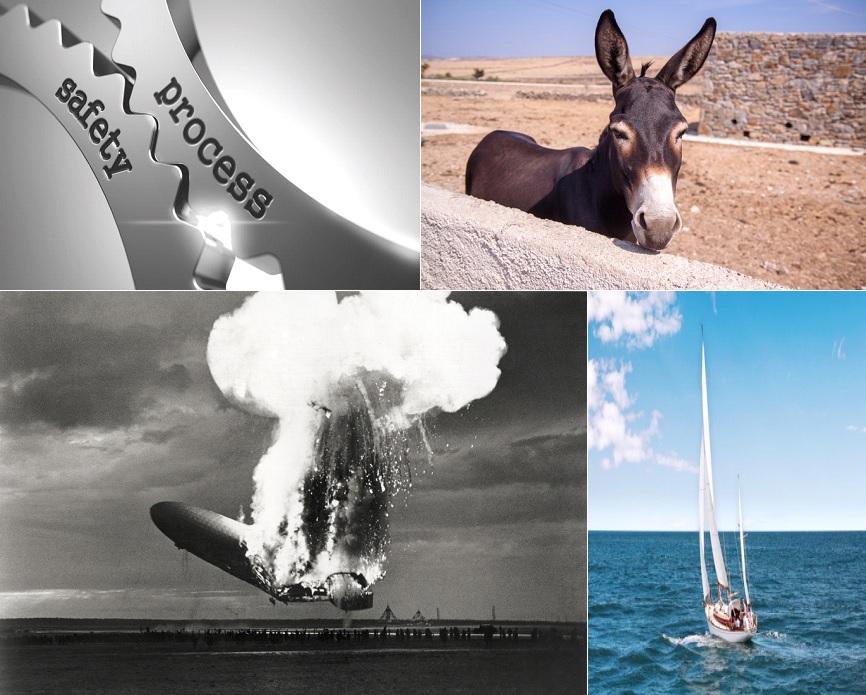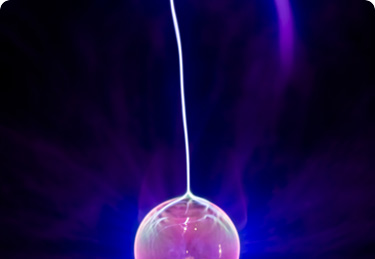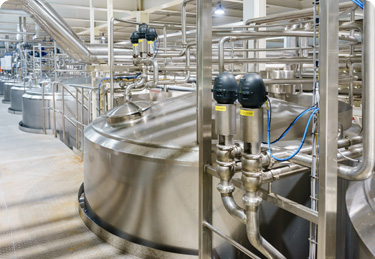Search
Process Safety, Hindenburg Airship Disaster, a Mule, a Yacht

WHAT DO THESE 4 THINGS HAVE IN COMMON?
Photos by Anna Kaminova and Kristel Hayes on Unsplash
Here’s a puzzler for you…
What does the Hindenburg Airship disaster of 1937, a mule, a yacht and process safety in 2021, all have in common? In this issue of Process Safety Dispatch, we find out. But first some definitions….
Definitions:
- Hindenburg Airship Disaster: took place 84 years ago in the skies above New Jersey as the hydrogen-filled ‘balloon’ with 97 persons on board caught fire and exploded on its approach to its mooring location. This, at the end of its first ever journey with passengers from Frankfurt, Germany to the USA.
- Process Safety: is a disciplined framework for managing the integrity of operating systems and processes handling hazardous substances. It deals with the prevention and control of incidents that have the potential to release hazardous materials or energy that could ultimately result in serious injuries, property damage, lost production, and environmental impact.
- Mule: the offspring of a horse and a donkey, especially, the offspring of a male donkey and a mare.
- Yacht: a sailboat with a mast used for racing or pleasure.
So, for our puzzler we have an airship full of hydrogen gas, a cross between a horse and a donkey, a yacht and a discipline to which many of us strive to adhere – yet there is a clear link. Read on to discover more…
Hindenburg is a name familiar to many, yet its significance is greatest for the few people alive today who remember the impact that this failure of German technology had on society at the time. The impact was compounded by the extensive photography and newsreel coverage in place to record the arrival of this impressive new invention. The great white heat of technology stalled. Yet looking back with our knowledge and understanding of all things process safety today, some interesting things emerge which aid our understanding of industrial safety.
The Hindenburg Airship’s buoyancy came about from the hydrogen gas contained inside its structured air frame. Note that the airship was NOT a hot air balloon, nor was it strictly a ‘blimp’ because its shape was maintained by a metal framework. It nevertheless achieved lift, like a hot air balloon, through the difference in densities between its internal gas and the surrounding air.
Theories abound over what actually ‘caused’ the disaster [Ref 1]. Looked at through the eyes of the modern-day process safety professional in 2021, one would have to question the wisdom of suspending a hundred people or more underneath ‘a bag’ containing one of the most easily ignitable gases known to man. [There is a warning here for those developing hydrogen fuel cells – but that’s another story]. As a process safety professional today, we would also want to undertake a wholistic review of the incident, perhaps using a systematic approach from Process Safety such as ‘Event Tree Analysis’. In any case, in order to address our puzzle, we confine ourselves to the ignition of the hydrogen gas.
Fuel – oxygen – ignition source: explosion hazard
There is little doubt that it was a hydrogen gas-air mixture that ignited. There was after-all 7 million cubic feet of hydrogen and surrounding air in abundance to potentially create a huge flammable mixture.
There are various eyewitness accounts of ‘fabric fluttering’ in a gas leak, fire on the port side, a fire behind the rudder and importantly several reports of a ‘dim blue flame’ (blue glow?) moments before the main flames appeared and in the same location. It is also known that the airship had a balance problem before the fire with crew actioned to adjust ballast in an attempt to compensate – which could be explained by partial loss of hydrogen and maybe even entry of air into the structure. The crew had also dropped ropes to begin the docking process and one at least had been connected to a ground winch before the explosion took place.
The blue glow: St Elmo’s fire is a term used by mariners to describe the blue glow that can appear atop the mast of a sailing ship. It is caused by corona discharge, a manifestation of static electricity, that develops in thunderstorm conditions when air is ionised at a sharp or pointed object in a strong electric field. A luminous plasma is created that appears as a blue glow at the point. So here we find our link to sailing yachts. [St Elmo, to some, in case you are interested, is the patron saint of sailors!]
To many people, the dominant ignition source theory for the Hindenburg disaster revolves around the blue glow. Corona discharges are generally of very low ignition energy when compared to other discharge types caused by static electricity and generally thought to be incapable of igniting most solvent vapors and gases; but remember the ignition sensitivity (minimum ignition energy (MIE) of hydrogen is very LOW). Hydrogen MIE is 0.019mJ, which is 20 times less than the MIE for common solvents found in the process industries. Hydrogen gas has been proven to be capable of ignition by Corona discharge in the laboratory [ref 3].
On process plant, corona discharges can occur in situations where ‘something’ has become very highly charged. That ‘something’ could be, for example, the end of a wire reinforcing spiral in a plastic hose, the sharp edge of a powder drum that has not been grounded, or even the extremities of an operator working in an electrostatically charged environment near an insulating flexible big bag (FIBC), for example. Ever felt a ‘tingle’ in your finger or your hair move as you walk across an insulating carpet?
Was there thunderstorm activity in the vicinity of the Hindenburg at the time of the explosion? YES. It’s remarkable that the approach to the mooring station was delayed to allow a thunderstorm to pass. During that delay, the airship captain apparently took his passengers on a tour over the New Jersey beaches whilst waiting! It’s important to understand that very strong electric fields are generated under thunderstorm conditions. It’s also important to understand that there are also strong and fluctuating electric fields in the atmosphere both before a thunderstorm strikes and after it has passed. We must conclude that the atmospheric conditions were conducive to corona discharge activity. There was even a mooring warp in place to provide an electrical connection to ground for the airship to allow strong corona current to flow. Of course, this also ties in with witness accounts of the blue glow. In the process industries, some outdoor facilities will even shut some production areas when thunderstorms approach to avoid the electrostatic ignition risk.
The Mule: For a bit of fun, we included the much-maligned mule. Interestingly enough, if you take a mule to the top of a mountain when a thunderstorm approaches, you can also see a blue glow emanating from the top of the mule’s ears. Mules, it seems, have many fine hairs on top of their ears and these will create the blue glow, the tell-tale sign of corona discharge. How about that for a static warning sign? Of course, as any mountaineer will know, such conditions are very dangerous not only for the mule but also for anyone in an exposed position on a mountain top in a thunderstorm. Corona discharges can precede a full-blown lightning strike – which is why some process plants would shut down as a precautionary measure.
Solution to the puzzler
So, there you have it. Strong electric fields, such as those that occur routinely when a thunderstorm is in the vicinity, can cause ionization of the atmosphere – particularly at corners, edges, or points of conducting objects and living creatures. This ionization can appear as a blue glow in extreme circumstances and is known colloquially as St Elmo’s fire – or to give its scientific name, corona discharge. Most Corona discharges are generally of low energy and would not be able to ignite most of the usual flammable atmospheres found on chemical plant although with flammable atmospheres of very low ignition energy and in the presence of extremely strong electric felids, ignition of low MIE gas atmospheres is possible.
The yachts mast will glow out at sea in a thunderstorm, as many ship’s skippers can testify, and we now know about corona from the ears of mules. A strong candidate ignition source behind the Hindenburg airship disaster was Corona discharge. Of course, it is the principals and practices of static electricity and Process Safety that bring all of this together.
Static electricity can cause fires and explosions on process plant. We are experts in process safety management. If you would like to talk through how our process safety consultants and specialists in static electricity can help you assess the dangers of static electricity on your plant, please contact us on 609-455-0001 or send us an email to [email protected].
References
- https://www.canberratimes.com.au/story/7151311/why-did-the-hindenburg-burn/?src=rss
- https://www.livescience.com/58987-why-caused-the-hindenburg-disaster.html
- Journal of Electrostatics v71, issue 6 December 2013

Get in touch
To learn more about our expertise and services in dust explosion prevention & mitigation, call us at +1 609 455 0001 or email us at [email protected] today.
We also offer tailored virtual and in-company process safety training programs on Dust Explosions, Static Electricity and HAC (Hazardous Area Classification) and more. Find further information here.










